Introduction
I was recently invited by my friends Jim Martin and Canon Explorer of Light Jennifer Wu to join them on a Photographic Safari in Tanzania.
The trip was designed to photograph the beginning of the Great Migration with the expectation of lush greenery and an abundance of newborns and young animals.
I had never seen the Great Migration and it was an item on my “bucket list”, so the decision was easy: I immediately agreed to join Jim and Jennifer on this trip.
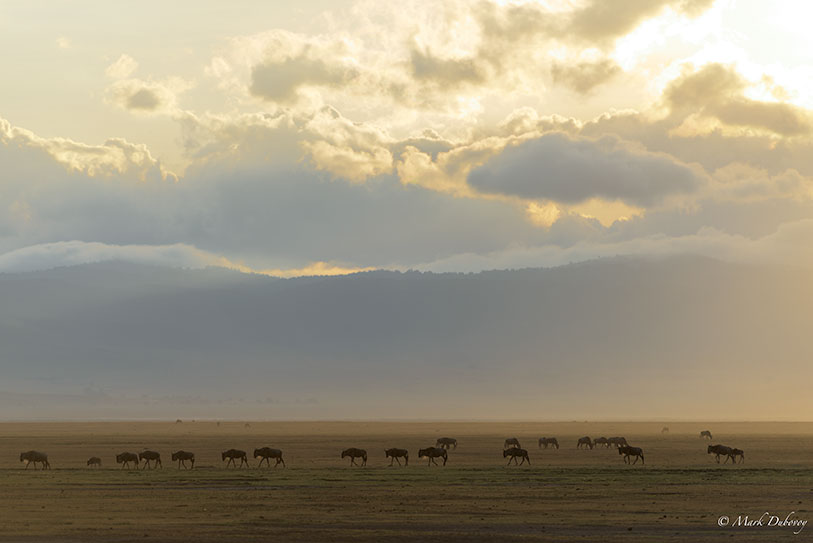
Migration sunrise.
Pre-visualization
I often speak about how I believe that pre-visualizing the types of images one wants to produce makes a very significant difference in the quality of the final images.
I could have gone to Tanzania carrying a smattering of all kinds of equipment and started shooting at random whatever stroke my fancy at the time. This would have led to far inferior results versus advance pre-visualization and advance equipment planning in order to have the equipment match the pre-visualized types of images.
Allow me to elaborate:
Before embarking on this trip, I felt that trying to photograph huge numbers of animals was not something I wanted to pursue. Somehow I felt that using this approach I would not be able to obtain strong enough images to tell the story.
I also felt that photographing single individuals would lead to a lot of the typical encyclopedia types of images that are so prevalent on the web, in magazines and in books. The solution for me was to try to photograph relatively small groups of animals and to emphasize the surrounding landscape in the images. While I was willing to accept larger numbers of animals in the distant background to put things in context, I wanted to make sure that the main subject was a smaller key group photographed in such a way that it would tell the story of what was happening at that moment and beyond.
I pre-visualized the images as having a good amount of compression and shallow depth of field, as I felt that this would allow me to guide an observer’s eyes to the important elements in a print, while still allowing the other elements to come through. I wanted the other elements to come through with less definition and some level of mystery.
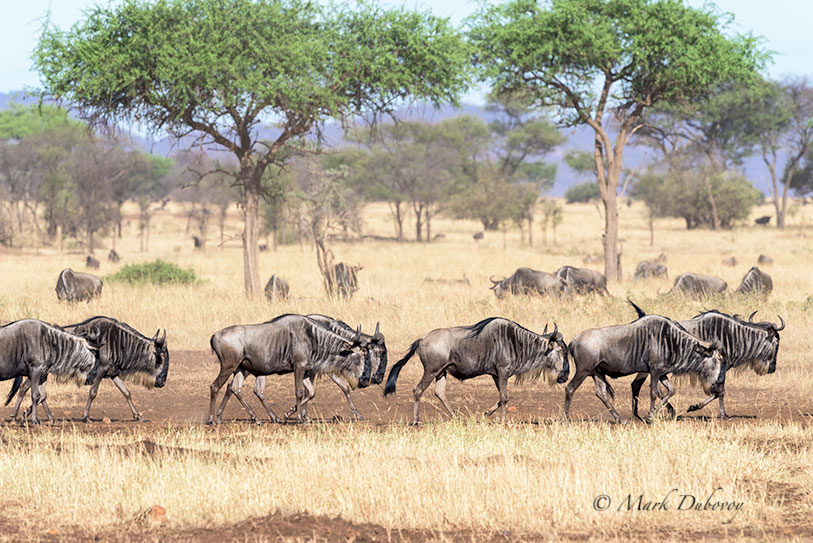
Wildebeest
I also determined that these were not the only types of images I wished to capture. Certain regions of the Serengeti are sometimes full of felines. I am a serious cat lover so I decided that besides the above types of images, I wanted to try to capture images of cats either displaying unusual behavior or under unique circumstances.
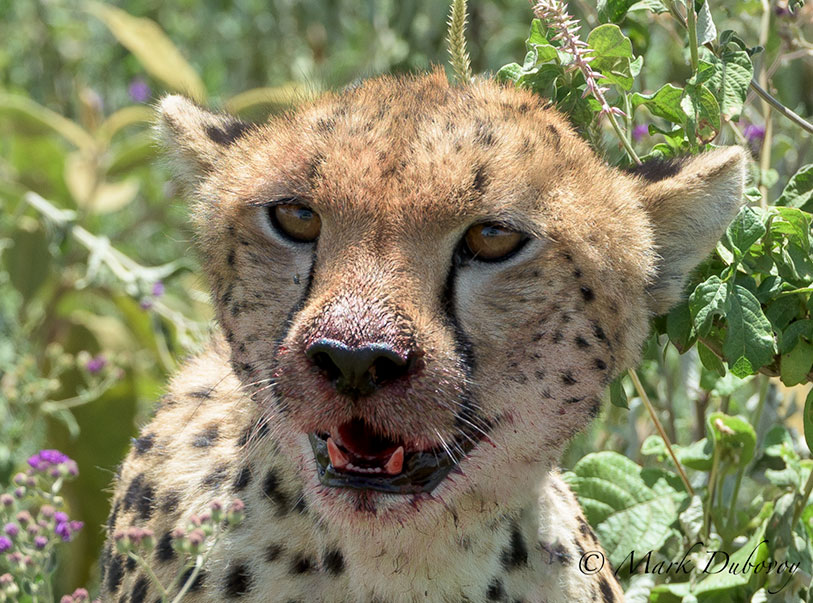
Cheetah eating prey.
Equipment choice
Once I had pre-visualized the types of images I wanted, it was time to pick the right equipment to capture those kinds of images.
Given the types of images I wanted to capture, and given the large open spaces in Tanzania, it quickly became evident that shooting with long lenses was imperative. It also became evident that a 35 mm DSLR would probably be the best photographic tool for this trip.
As most people who read my articles know, in general I am not a fan of 35 mm DSLR’s, but it is important to have the right equipment for each assignment. Since I did not own a 35 mm DSLR at the time, I ended up purchasing two Nikon D 810 bodies (although the D 810 is slower than the D 4s, I chose it because of its higher image quality).
I also purchased the latest version of the top of the line 70-200/F 2.8 and 500/F 4 Nikon lenses.
Having two bodies and two lenses would allow me to have a relatively compact (for Africa) kit and I would not have a need to change lenses in the Tanzanian dust.
Little did I know how bad the dust was going to be. It was truly awful! We encountered some of the worst dust I have ever experienced; at times just breathing was a challenge. Having two bodies without a need to change lenses turned out to be a massively brilliant decision.
Having been to Africa many times before, I knew that tripods, monopods, clamps, fancy tripod heads and assorted other contraptions simply do not work for this type of photography. The best approach I have found is to use bean bags. During this trip I used a combination of the bean bags provided by our tour operator with a bean bag from Gura Gear that I purchased prior to the trip. This also turned out to be the right decision.
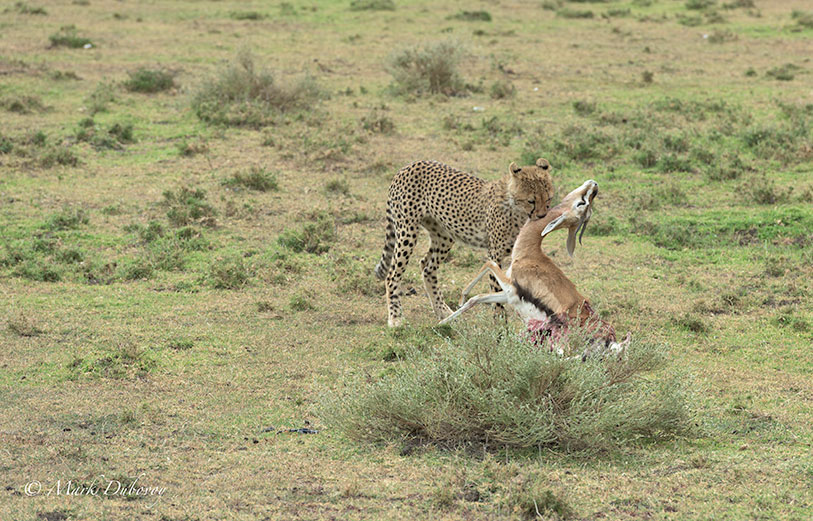
Cheetah kill.
Climate change
Climate change is a fact of life and it is affecting everything on this planet. Case in point: The Great Migration.
While this trip had been meticulously planned to intersect The Great Migration at the best time and the best locations, Climate Change affected everything. There had been a severe lack of rain, thus forcing the animals to move North much earlier than normal. Herbivores need green vegetation to eat, and there simply was not enough food for them to survive unless they moved North quickly. Furthermore, there was not enough vegetation for them to eat in the normal path of The Great Migration, so the large groups of animals split into smaller migrations that took detours to other areas where they could find food.
I will not be surprised if in the future The Great Migration will continue to be comprised of a group of smaller migrations moving along more varied paths than has been the case in the past.
Because of these facts on the ground, we had to modify our schedule and we also had to move North and East much more quickly than originally planned. This resulted in our witnessing some completely unexpected and truly extraordinary events. The fact that we were able to be fast and nimble allowed us to see some very large groups of animals migrating during the last few days of our trip. I guess I can now check The Great Migration box in my bucket list.
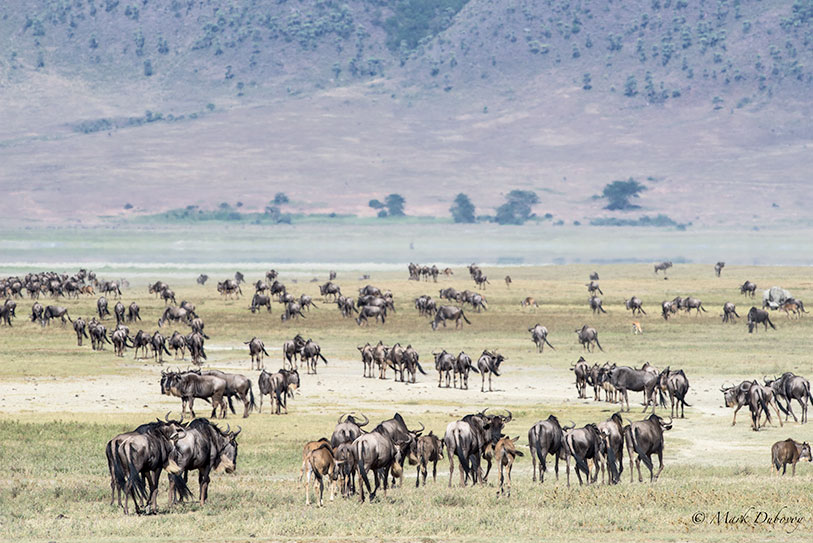
Starting the long trek
Extraordinary
I have been on a number of Safaris, but this one turned out to be extraordinary. We experienced a number of events that were truly once in a lifetime experiences.
For starters, please look at the image at the beginning of this article of two Cheetah on a tree.
We all know that animals adapt anatomically through natural selection. Leopards, for example, take their prey up a tree in order to protect it from other predators and scavengers. Therefore, the shape of the claws, the paws, arms, legs, muscles, etc. have evolved into a fine tuned machine that can easily climb trees with a very heavy load (the prey) carried in the mouth.
Lions are not nearly as well adapted to climbing, although in certain geographical regions they are (very sporadically) seen on trees. We were told that this was very rare, but it does happen sometimes. We were lucky enough to see lions on top of trees several times!
Cheetah, however, are a different story. They have evolved to be the ultimate runner. They do not have retractable claws and the shape and structure of the claws, paws, arms, legs, muscles, etc. are all ill adapted for climbing. We were told by experts that no one has ever seen an adult Cheetah climb a tree. They are too heavy and cannot get enough grip. We were also told that young Cheetah are much lighter, but are too weak to get enough grip. However, in extremely rare occasions a persevering Cheetah within a very narrow age range around 1 year old can muster enough strength and agility before it is too heavy to actually make it up a tree. We were told that the chances of seeing this were so remote that neither our trackers nor us would see it during our lifetimes.
So here is what happened: Around noon one day we saw a mother and several young Cheetah walking across one of the immense plains in the Serengeti. We decided to follow them and spent about half an hour near them until they finally settled in the shade near several large trees. The weather was very warm and the Cheetah were clearly hot and tired. A few minutes after they settled in the shade, they all fell asleep.
This is when decisions can dramatically change photographic opportunities. The question was: Do we stay and wait to see if they wake up, or do we move on and try to find something else? We decided to wait. And wait we did. My recollection is that we waited close to an hour, and then, several large birds landed on the tree branches. They were quite noisy and they woke up the Cheetah cubs first and then the mother. The cubs were very curious about the birds and really wanted to climb up to the top of the tree. They tried in vain to climb the tree multiple times as did the mother.
Eventually, one of the cubs figured out a way to leap onto a low branch and climb up from there. He never made it to the top, but he reached a higher branch and looked very proud of himself. The other cubs then followed and each one of them managed to climb to different parts of the tree. It seemed to me that the cats greatly enjoyed the high vantage point and spent some time scanning the terrain. Cheetah are notorious for trying to find elevated vantage points to scan the terrain and look for potential prey.
Needless to say, we were ecstatic to have witnessed such a rare event.
In terms of other animals, we saw an elephant being born; several lion kills; we saw some very large lion prides (as large as 24 lions) and witnessed all kinds of different lion behaviors; we also saw two hyena clans fighting for a Wildebeest kill, trying to steal the head and other body parts from each other and many other amazing occurrences including some magnificent scenes of the Great Migration in beautiful light.
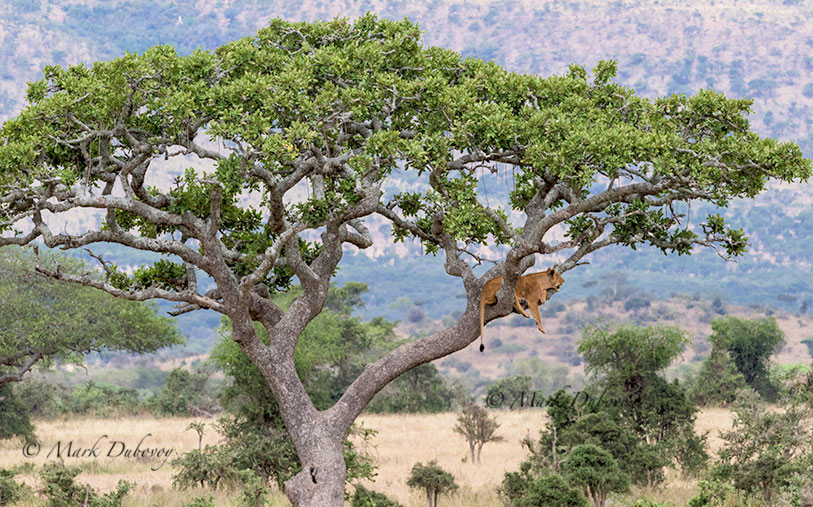
Lioness relaxing on a tree branch.
How did the equipment perform?
To put it in two words: Somewhat disappointing.
This may be a personal bias, but I continue to find 35 mm SLR’s to be clunky, unnecessarily complicated and quite un-ergonomic. Sometimes I am impressed by all their capabilities, but often times they can be really frustrating to operate.
The Nikon 500 mm lens is capable of producing very high quality images, but in the field under actual shooting conditions I found the autofocus system in the D 810 to be somewhat choppy and not up to the task. Even in 3D mode the system failed to focus properly a lot of the time. The situation with the other D 810 body and the 70-200 lens was quite similar. When two bodies with two different lenses act the same way, I tend to think that this is the way the system works, as opposed to worrying about whether a body or a lens might have a problem.
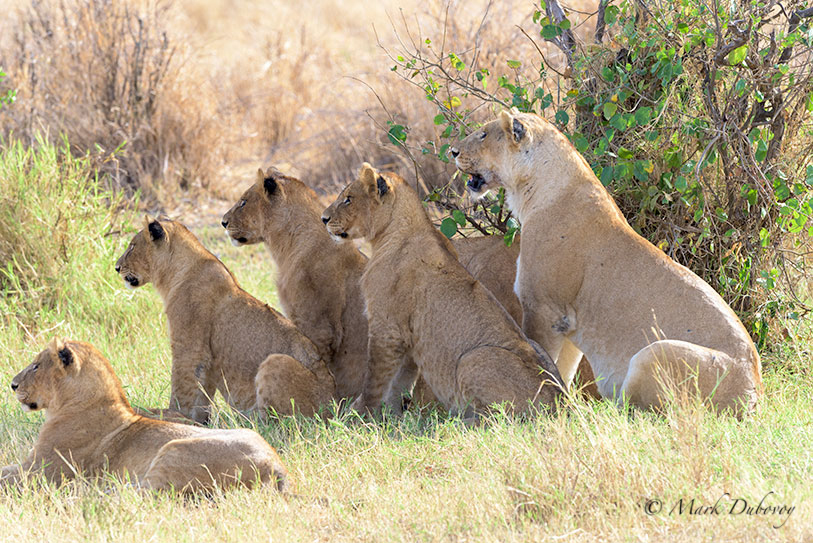
Pride on full alert.
I also found the image stabilization system in both lenses to be a lot worse than advertised. While it may work OK for some people in some situations, it did not work well for me in Tanzania. This was the case even with the camera and lens resting very solidly on bean bags while shooting.
In the end, I reverted to lots of manual focus intervention and image stabilization turned off. As long as my shutter speed was at least the number one divided by three times the focal length of the lens, I consistently obtained better images versus using image stabilization at a shutter speed of, say, one divided by the focal length of the lens.
While a pair of 35 mm DSLR’s was the correct choice for the types of images I wanted to create, my bias against these cameras was reinforced one more time. It is high time that they be radically redesigned. One also has to wonder if at some point in the future there will be a mirrorless camera that renders them obsolete.
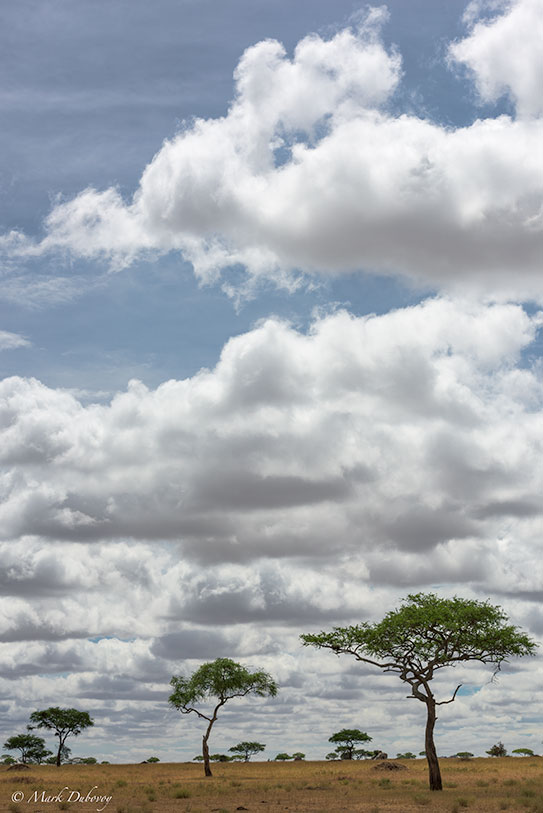
Triple Treat
Epilogue
This trip to Tanzania turned out to be truly special. Even with the effects of Climate Change, we were able to observe amazingly special scenes and fascinating animal behavior.
While 35 mm DSLR’s continue to disappoint, they were definitely the right tool for my pre-visualized types of images during this trip.
I believe I was able to achieve the style I pre-visualized for my images, so I hope the reader will enjoy and appreciate the photographs presented in this article.


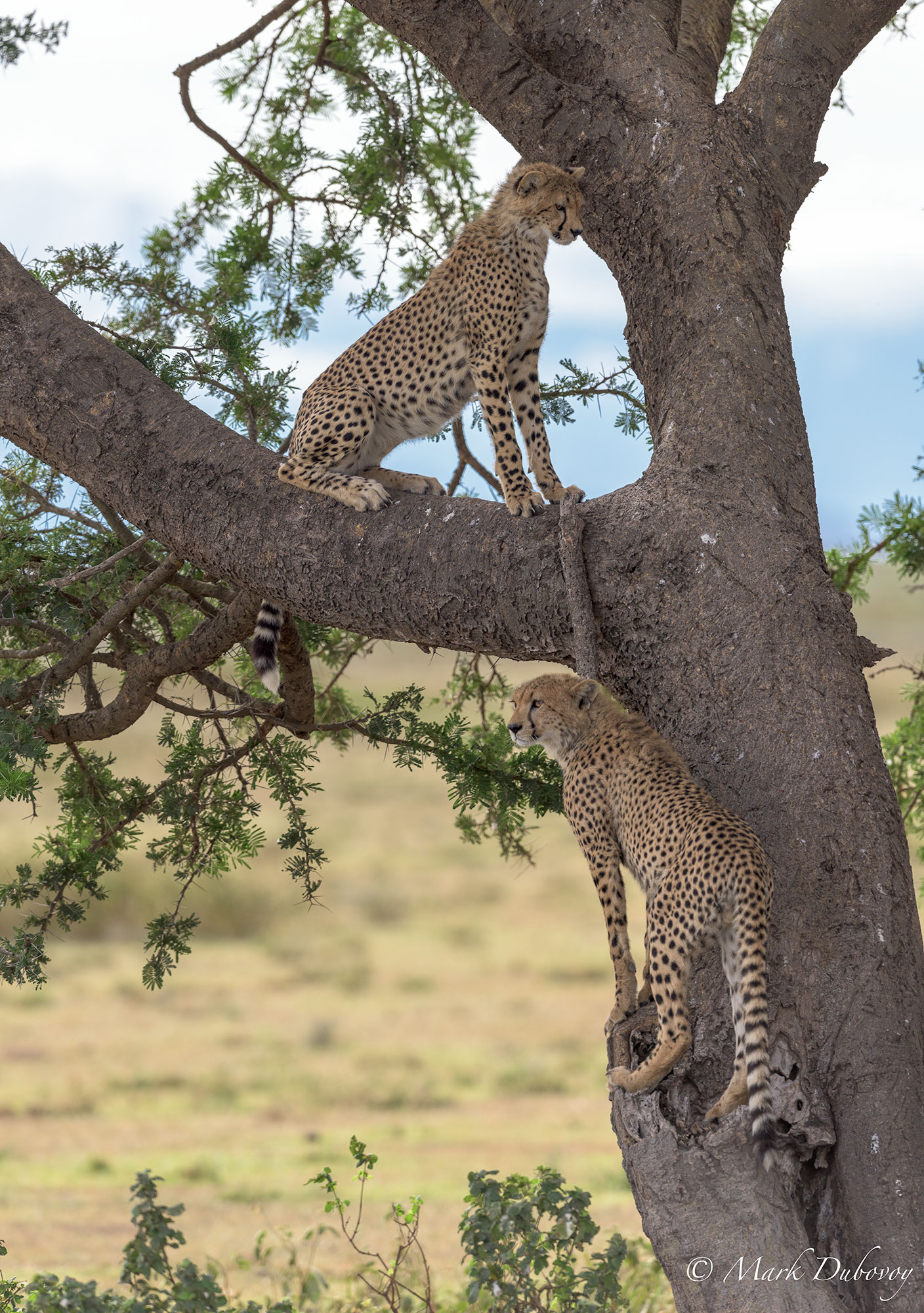



Your Thoughts